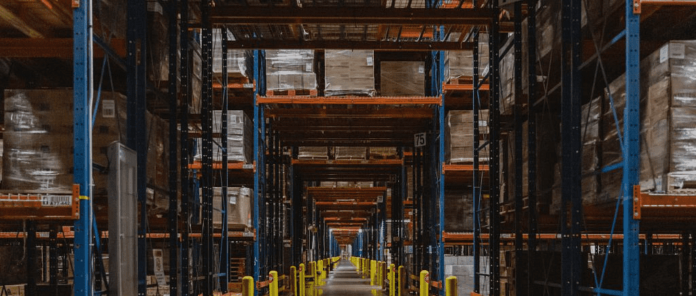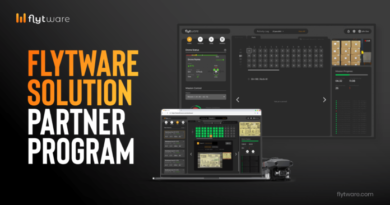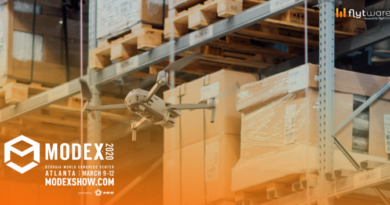Drone Technology Vastly Improves Performance for Romark Logistics
With ‘Continuous Improvement’ as one of its seven core values, Romark Logistics (Romark) has become a pioneer in the supply chain and logistics sector since 1954. As a top third-party logistics and cold-chain provider in North America, Romark services leading food, beverage, pharmaceutical, commodities, and retail customers around the world. However, it too faces disruption in its operations because of e-commerce, higher supply chain velocities, consumer expectation on same day delivery – and most recently – the COVID-19 pandemic.
In order to sustain and enhance its competitive advantage, Romark has continued investing in innovative solutions for warehousing. One example is how the company restructured its distribution center (DC) in Lancaster, Texas to use very narrow aisle (VNA) racking, substantially improving space utilization. An investment was also made in swing-reach trucks, which are more capital expensive, but more productive and require less training for new operators.
The Challenge With Manual Inventory Counts
The challenge that comes with six-feet VNAs is manual counts of the warehoused inventory, containing full pallets with front-facing barcodes, stored one-deep in the VNA racks. This involves a labor-intensive, time-consuming process, with both people and equipment tied up, that could otherwise be used in picks / put-aways or shipping / receiving.
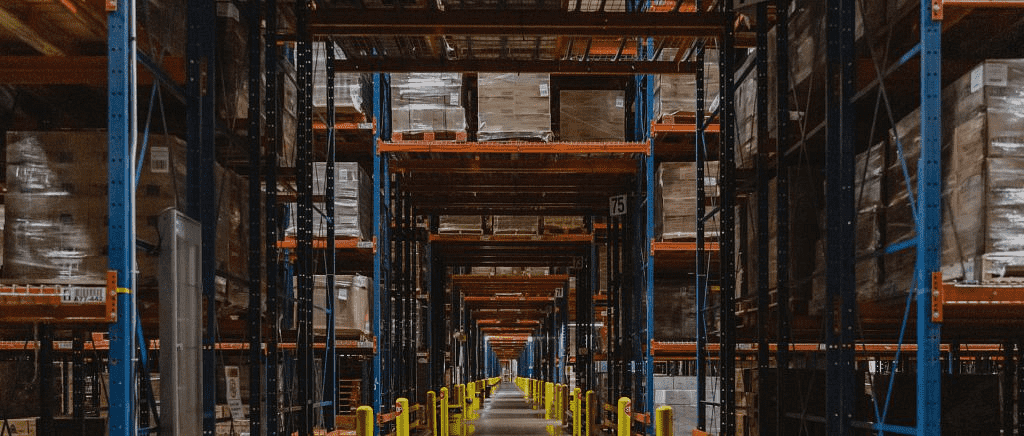
As a 24/7 facility dedicated to a large, US-based food manufacturer, Romark’s Lancaster warehouse has to continuously improve and optimize its fulfillment metrics. Manual inventory counts tend to have an adverse impact on these metrics, especially amidst tight labor markets, peak seasons, and pressure on operating margins.
Any attempt to increase the frequency of inventory counts would imply a corresponding increase in labor, time and equipment consumption. Yet, as an industry-leading 3PL, Romark brings in-depth, more frequent, and highly accurate inventory insights to its customers.

“As a 3PL, we are faced with higher velocity supply chains, dynamic service level agreements with our customers, and their expectations of same-day delivery. Frequent, accurate and in-depth inventory data is key to our ability to manage customer inventory efficiently, minimize inaccuracies, avoid adjusting orders and differentiate ourselves in a highly competitive marketplace.”
Marc Lebovitz
President, Owner – Romark Logistics
Aerial Automation Solutions
As part of its year-long search for warehouse automation solutions, the continuous improvement and innovation team at Romark had been looking for technology-led solutions that could automate the pallet counts, without disrupting inventory operations.
After evaluating various options such as manually flown drones, radio frequency identification (RFID) tags, and ground robots with barcode scanners, Romark established a few key principles that must be met for replacing manual counts:
- Such a solution must ensure the safety and security of Romark’s warehouse workers and be able to function safely in an active warehouse environment.
- Any solution Romark adopts must be fully independent and autonomous i.e. requiring no human intervention.
- In a 24/7 operation, the solution cannot be disruptive to the workflow and must have a minimal impact on pick and put away activity in the storage environment.
- For such a solution to scale across aisles and across Romark’s sites, it must be extremely user friendly, easy to integrate with the warehouse management system (WMS), and cost-effective.
In this context, autonomous drones stood out as the best automation technology at Romark’s DCs for inventory counts, and associated use-cases such as empty bin audits. The use of airspace meant that ground operations would not be affected, and the ability to read barcodes meant that new (potentially wasteful) investments in RFID tags could be avoided.
“Warehouse automation technologies such as drones are central to continuous improvement initiatives at Romark. I expect autonomous drones to help us better leverage our investments in VNA racking and swing reach trucks, freeing up valuable human and capital resources that would be otherwise engaged for manual inventory counts.”
Michael Beasley
Continuous Improvement Manager – Romark Logistics
Drones Automation Solutions from FlytBase
To explore the possibility of deploying autonomous drones at relevant Romark DCs, the 3PL provider contacted FlytBase, an enterprise drone software company whose mission is to help businesses automate and scale drone operations. With a hardware-agnostic platform that features edge intelligence, cloud connectivity and application programming interfaces (APIs), FlytBase can leverage cost-effective drones, at scale, for indoor applications. The company’s drone solution can be used for counting inventory in warehouses where GPS connectivity is poor, people and equipment are moving around, and drones need to navigate tall racks and very narrow aisles.
FlytWare Inventory Drones
FlytBase’s autonomous solution, FlytWare, is designed for aerial inventory scans at warehouses, DCs, cargo hubs and other inventory-heavy facilities.
FlytWare leverages the sustained trend in drone hardware commoditization, which has led to off-the-shelf, cost-effective, reliable devices that are lightweight and extremely stable during autonomous flights. FlytWare features not only precision landing, autonomous charging and collision avoidance, but also an operator-friendly dashboard that requires minimal training. With the cloud-connected option built into the solution, FlytWare can be used at each hub – as well as at corporate headquarters – to plan, execute, monitor, repeat and audit inventory counting missions.
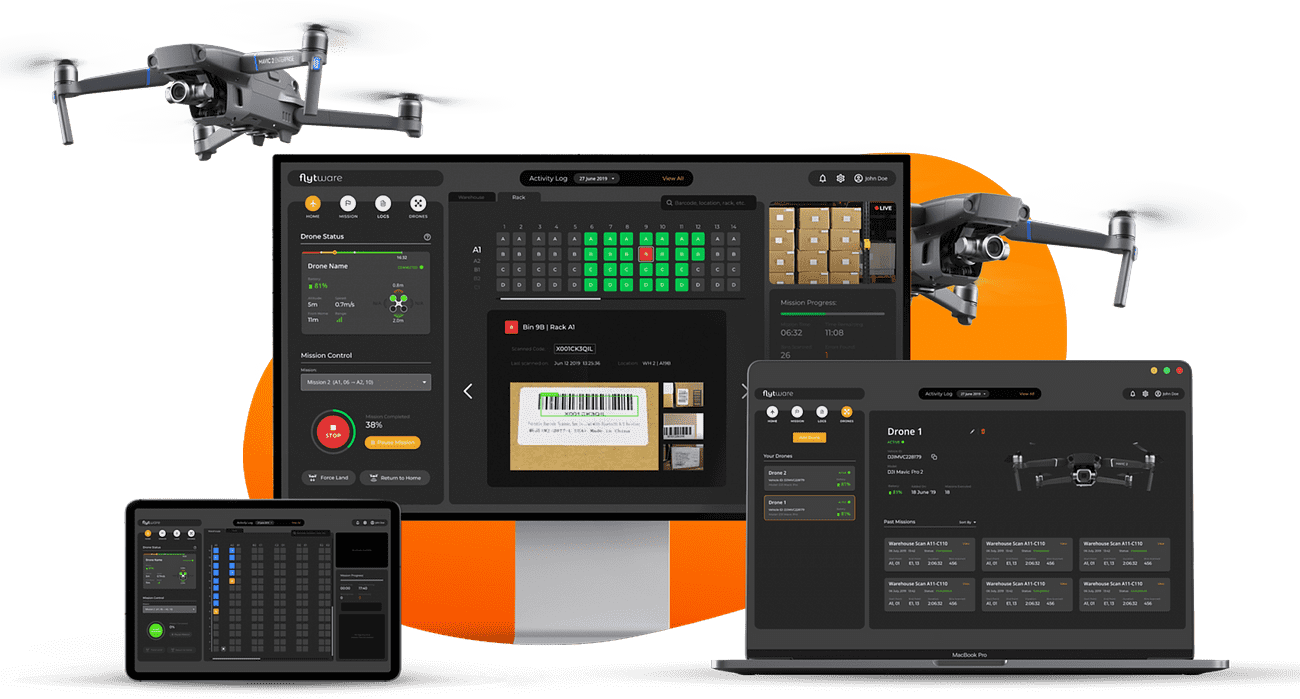
Proof of Concept (PoC) → Pilot → Production
Adopting any cutting-edge technology requires a careful analysis of its costs, benefits, potential risks, impact on business processes, sustainability and scalability. While evaluating the feasibility of augmenting (and soon replacing) manual inventory counts with FlytWare, Romark had to consider the potential cost savings, payback period, impact on employee job satisfaction, and likely improvements in safety. Romark also has to stay ahead of the curve by proactively adopting the newest warehouse automation technologies and deploying them at scale.
To minimize the risk of using FlytWare, Romark agreed to a three-phase approach, starting with a proof of concept deployment at the Lancaster, DC followed by a pilot, and eventually full-scale production deployment, once the solution performed as per Romark’s expectations.
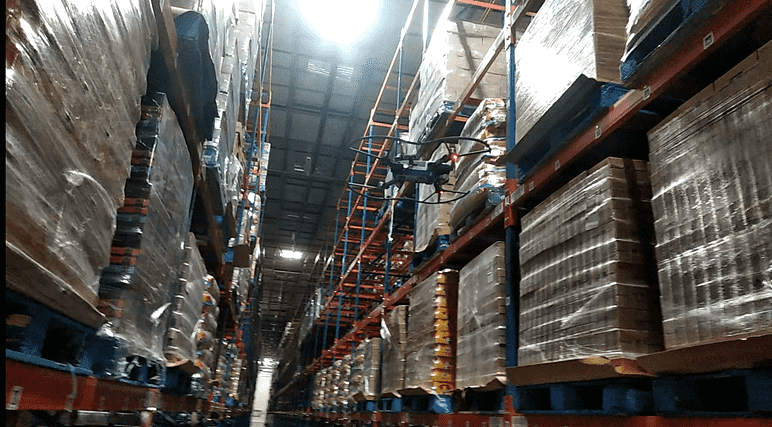
Proof-of-Concept
FlytBase identified the biggest risk to FlytWare deployment at Romark’s Lancaster DC: the ability to fly autonomously, safely, and reliably within six-feet wide aisles. Such narrow aisles are a tough environment for drones, given the likelihood of collisions, the relatively smaller field of view, and the varying degrees of illumination across the rack height.
Thus, indoor autonomous navigation was at the core of the PoC, which was successfully deployed in late 2019. It provided Romark an opportunity to see the operator dashboard in action, determine the accuracy of barcode detection and share expectations with respect to WMS integration and data comparison.
The continuous interactions with the warehouse operations, inventory, IT and innovation teams during the PoC also unveiled adjacent use-cases for FlytWare, such as empty bin audits, put-away audits, aerial scans of bulk storage and even outdoor applications such as identifying containers and trailers in the yard.
With a successful PoC in place, Romark agreed to proceed to a pilot deployment of FlytWare in multiple VNAs at Lancaster DC.
Pilot
It was important to Romark Logistics that manual inventory processes be replaced by truly autonomous drones, not something that would still require human intervention. Not only were the FlytWare drones required to fly autonomously and scan barcodes automatically, but the precise landing/takeoff, autonomous battery charging, comparison with WMS data and fleet operations management should also be fully automated, for a scalable solution.
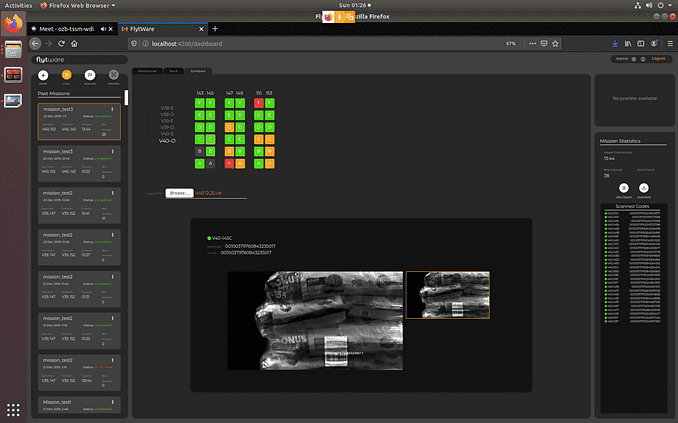
This was successfully demonstrated by FlytBase during a pilot deployment in early 2020. Dozens of fully autonomous missions were run, to confirm stable drone flights, consistent barcode detection, precision landing on charging pads, crossing from one aisle to another, etc.
More importantly, the pilot unearthed some of the key considerations for a production deployment, such as:
- Automatic triggering of overhead, motion-activated lights
- Indoor radio frequency (RF) Range of the drone
- Operational improvements to ensure all pallet barcodes can be successfully read
- Optimal location of the ground station, charging pads, etc.
- The ideal mix of home, service and charging locations
“As technology continues to advance, so must our warehousing strategies. In preparation for new technologies, we adjusted our storage strategy from the more common floor storage or double deep to now having a Very Narrow Aisle configuration which resulted in a simpler single location, single pallet solution. This has allowed us to continue to invest in new automation technology for the warehousing industry, starting with FlytWare’s Inventory drone.”
Kevin Gamber
General Manager – Romark Logistics
Production
As an early adopter of FlytWare, Romark has played a significant role in guiding the FlytWare production roadmap, not only from a features and capabilities point of view, but also in terms of ease of integration into warehouse operations, data security and privacy, and industrial-grade reliability. The FlytBase team is hardening FlytWare to be production-ready in the coming weeks, driven by extensive feedback from the Romark team.
One of the highlights of this engagement has been the continuous and deep involvement of the senior leadership at Romark, whose decades of experience in the warehousing industry has enriched FlytWare in numerous ways. By sharing the ground realities of warehouse operations, and the challenges faced because of volatile supply chains (as evidenced in the current pandemic), Romark has helped FlytBase appreciate the pain points of manual inventory counts, and the opportunity to digitally transform these operations via drones.
Automate, Then Scale
With more than a dozen large DCs across the US, Romark looks forward to scaling autonomous drones deployments beyond the Lancaster warehouse. In fact, using the cloud-connected FlytWare dashboard – as a centralized access point to plan and oversee inventory counting operations across multiple warehouses – will enable Romark to offer inventory analytics and insights to its customers.
Deploy FlytWare Today
Streamline your DC inventory audits, and honor your 3PL customer service level agreements, by deploying drone solutions that feature live video feeds, date-wise image archives, and location-wise barcode data.
Write to us at flytware@flytbase.com or schedule a call with the FlytWare team.
